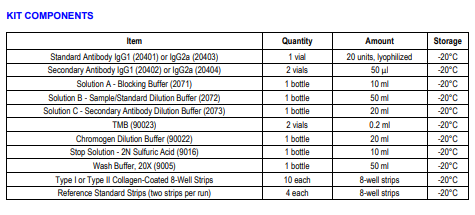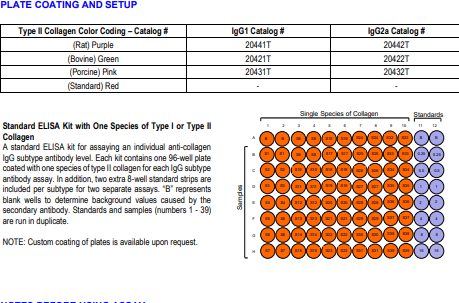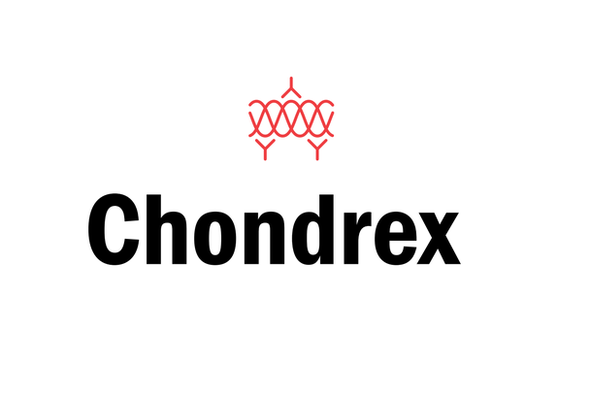Rat Anti-Bovine Type II Collagen IgG2a Antibody Assay Kit, TMB
- SKU:
- 445-20422T
- Size:
- 1 kit
- Shipping:
- Gel Packs
- Storage:
- -20 C
Description
Rat Anti-Bovine Type II Collagen IgG2a Antibody Assay Kit, TMB - Cat Number: 20422T From Chondrex.
Research Field: Arthritis, Immunology
Clonality: N/A
Cross-Reactivity:
Host Origin: N/A
Applications: N/A
Isotype: N/A
Detection Range: 16 units/ml-0.25 units/ml
Sample Type: Serum, Plasma
Concentration: N/A
Immunogen:
PRODUCT SPECIFICATIONS
DESCRIPTION: Assay kit to quantify rat anti-collagen antibodies
FORMAT: Pre-coated 96-well ELISA Plate with removeable strips
ASSAY TYPE: Indirect ELISA
ASSAY TIME: 4.25 hours
STANDARD RANGE: 16 units/ml to 0.25 units/ml
NUMBER OF SAMPLES: Up to 39 (duplicate) samples/standard plate (will vary for custom kits)
SAMPLE TYPES: Serum and Plasma
RECOMMENDED SAMPLE DILUTIONS: 1:1000 (at least)
CHROMOGEN: TMB (read at 450 nm)
STORAGE: -20°C
VALIDATION DATA: N/A
INTRODUCTION
Autoantibodies to type II collagen play a primary role in the collagen induced arthritis (CIA) model. However, autoantibodies are not always capable of inducing arthritis due to the inability to activate a complement, the first critical step in the activation of inflammatory cascades.
Therefore, instead of IgG1, the production of IgG2a and IgG2b subtype autoantibodies which are capable of activating the complement cascade is essential in the development of arthritis. In fact, the immunization of type II collagen emulsified with incomplete Freund’s adjuvant develops severe arthritis in rats by primarily eliciting IgG2a and IgG2b antibodies against type II collagen. However, pretreatment with immunization of type II collagen mixed with aluminum adjuvant reduces severity of arthritis by inducing an anti-collagen antibody subclass shift from IgG2a and IgG2b to IgG1 (1). These results demonstrate the importance of determining the IgG subtype of the antibodies against
the heterologous collagen used for immunization as well as the rat type II collagen for the evaluation of the immune response in the rat CIA model (2). In addition, this is especially important for the evaluation of immune modulating adjuvants which can be used for a treatment of autoimmune diseases such as RA (3).
Chondrex provides Rat Anti-Collagen IgG Subtype ELISA Kits for further analysis of antibodies in rat serum from the rat CIA model. These kits can also be used to determine antibodies to type I collagen upon request. Please contact Chondrex, Inc. customer service at
support@chondrex.com for more information on custom type II collagen and type I collagen-coated plates.
Note: The antibody-antigen affinity may vary significantly among serum samples and the IgG subtypes may recognize different epitopes.
Therefore, the total IgG concentration calculated as the sum of the IgG subtypes may not be the same as the total IgG levels determined by the Rat Anti-Collagen IgG ELISA Kits


NOTES BEFORE USING ASSAY
NOTE 1: It is recommended that the standard and samples be run in duplicate.
NOTE 2: Warm up all buffers to room temperature before use.
NOTE 3: Crystals may form in Wash Buffer, 20X when stored at cold temperatures. If crystals have formed, warm the wash buffer by placing
the bottle in warm water until crystals are completely dissolved.
NOTE 4: Measure exact volume of buffers using a serological pipet, as extra buffer is provided.
NOTE 5: Cover the plate with plastic wrap or a plate sealer after each step to prevent evaporation from the outside wells of the plate.
NOTE 6: For partial reagent use, please see the assay protocol’s corresponding step for the appropriate dilution ratio. For example, if the
protocol dilutes 50 µl of a stock solution in 10 ml of buffer for 12 strips, then for 6 strips, dilute 25 µl of the stock solution in 5 ml of buffer.
Partially used stock reagents may be kept in their original vials and stored at -20⁰C for use in a future assay.
NOTE 7: This kit contains animal components from non-infectious animals and should be treated as potential biohazards in use and for
disposal.






